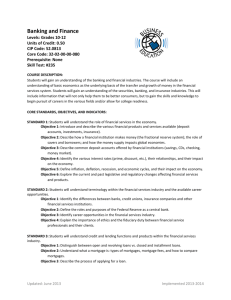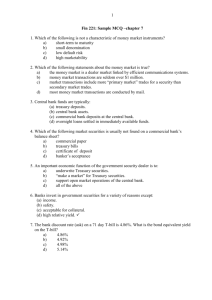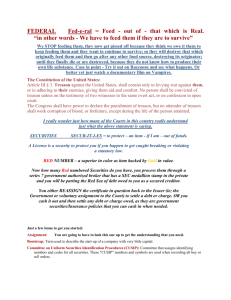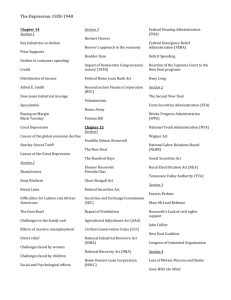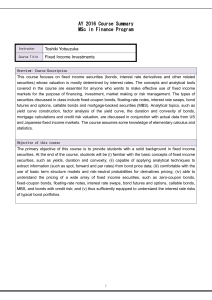Chapter 1 PowerPoint
advertisement
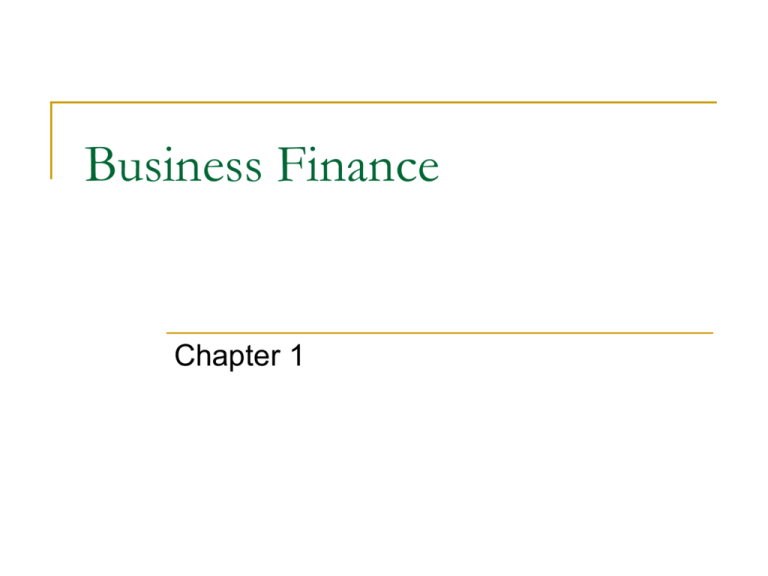
Business Finance Chapter 1 Financial management is concerned with managing a corporation’s money Where to invest money Whether or not to replace an asset When to issue new stocks or bonds How to raise money Functions of Financial Management Allocate funds to current and fixed assets Obtain best mix of financing Develop an appropriate dividend policy Acquire new funds Credit management Inventory control Receipt and disbursements of funds Possible Goals of Financial Management Earn the highest profit Increase the value of the firm Maximize shareholder wealth Maximize management wealth Act in a socially responsible or ethical manner Forms of Business Organization Sole proprietorship Partnership Corporation Subchapter S Sole Proprietorship Single person ownership Unlimited liability for owner Profits/losses taxed as though they belong to owner Partnership Two or more owners Unlimited liability for owners Articles of partnership specify ownership interest, methods of distributing profits/losses, and means of withdrawal Losses/profits allocated directly to partners Corporation Legal entity Formed through articles of incorporation Owned by shareholders whose liability is limited to investment Continual life Easy division/transfer of ownership Managed by a Board of Directors Pays taxes on its income Remaining income is paid to shareholders as dividends Shareholders pay taxes on dividends leading to double taxation May form a Subchapter S Corporation to prevent double taxation How will we see the difference? Balance sheet – ownership Raising funds Dividends paid Cash flow – owner’s draw Agency Theory Agents act on behalf of others Ex: Real estate agents, sports agents Relationship between the owners and managers of a firm Two different groups in a public corporation May cause conflicts of interests in running the company Sarbanes-Oxley Act 2002 response to corporate scandals Federal law drafted that increased regulation of corporations’ accounting practices and governance Focus is to make sure that corporations present financial information accurately Creates an Oversight Board that increases standards for auditing Current Issues in Finance Risk vs. return Short–term vs. long-term Raising money through stocks or bonds Financial Markets Meeting place for people, corporations, and institutions what need money or have money to lend or invest Public financial markets – government that is borrowing for highways, education, welfare or other public activities Corporate financial markets – corporations raising money What is bought or sold is called a “security” An investment instrument issued by a corporation, government, or other organization which offers evidence of debt or equity Securities include stocks, bonds, notes, options, calls, and leases Money markets – deals with short-term securities that have a life of one year or less (ex: CD sold by a bank) Capital market – deals with long-term securities that have a life over one year Who are the primary participants in the capital markets? U.S. Treasury, other agencies of the federal, state and local gov’t, and corporations The international capital markets are rapidly increasing in importance. Influenced by: Iron curtain "collapse." Reunification of East and West Germany. A more competitive and tariff-free Europe. The North American Free Trade Agreement (NAFTA). Economic growth of Asian countries led by China. Competition for Funds in the U.S. Capital Markets U.S. Treasury sells short/long term securities for financing Treasury bills (or T-bills) -short-term securities that mature in one year or less from their issue date. Interest paid as difference between purchase price and payment at maturity For example, if you bought a $10,000 26-week Treasury bill for $9,750 and held it until maturity, your interest would be $250 Treasury notes and bonds - securities that pay fixed rate of interest every six months until maturity Difference between them is length until maturity. Treasury notes mature in 1-10 years from their issue date. Bonds mature in more than 10 years from their issue date. Treasury bonds http://finance.yahoo.com/bonds Corporations sell securities for funds also Common stock – company sells ownership interest with voting rights to control company for capital Preferred stocks - usually have a fixed dividend and carry no voting rights. They have priority over common stocks in the case of bankruptcy and with regard to dividends. They technically have an unlimited life but often are redeemable. Common stock is sold in two ways by corporation Initial Public offering (IPO) Secondary offering Securities are later traded by owners in security markets Primary markets in the U.S. the New York Stock Exchange (NYSE) and the NASDAQ American Stock Exchange (AMEX). Exchanges of lesser importance include the Chicago, Pacific, Detroit, Boston, Cincinnati, and PBW (Philadelphia, Baltimore, and Washington) exchanges. NASDAQ is electronic http://finance.yahoo.com/ Regulation Organized securities markets are regulated by the Securities and Exchange Commission (SEC) and through selfregulation. Laws governing securities trading Securities Act of 1933: Requires full disclosure of all pertinent investment information on new corporate security issues. Securities Exchange Act of 1934 - created the Securities and Exchange Commission (SEC) and empowered it to regulate securities markets. Securities Acts Amendments of 1975 Directed SEC to supervise development of national securities market Which is most popular? Corporations tend to raise funds through debt more often than equity

